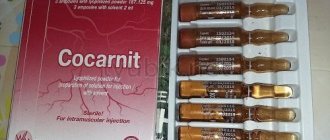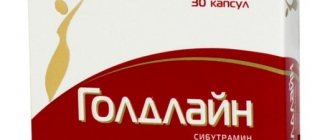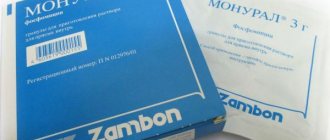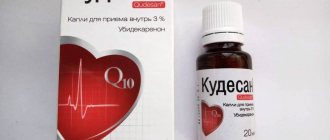Release form and composition
The active substance Baralgin is a non-narcotic drug and is a derivative of pyrazolone.
- Baralgin tablets: 20 pcs per pack. 1 tablet of Baralgin contains: metamizole sodium 500 mg, pitofenone hydrochloride 5 mg, fenpiverinium bromide 100 mcg.
- Baralgin injection solution: 5 ml in ampoules of 5 pcs. packaged. 1 ampoule of Baralgin contains: metamizole sodium 2.5 g, pitofenone hydrochloride 10 mg, fenpiverinium bromide 100 mcg.
Previously, the drug Baralgin was registered in Russia, which included three active ingredients: pitofenone, metamizole sodium and fenpiverinium bromide. Since 2009, the drug Baralgin-M, produced by the Indian company Aventis Pharma, has been registered and distributed through the pharmacy chain. Baralgin contains one active component - metamizole sodium.
Baralgin is produced in tablets and suppositories. Baralgin solution is also produced in ampoules - for IM, IV injections.
According to the instructions, the Baralgin tablet contains 0.5 g of analgin, 0.005 g of an antispasmodic (the effect of which is similar to the effect of papaverine) and 0.0001 g of a ganglion blocker. Accordingly, in a 5 ml ampoule of Baralgin – 2.5 g/0.01/0.0001 g, and the composition of Baralgin in suppositories – 1/0.01/0.0001 g.
Baralgin is produced by:
- in tablets (10 tablets per blister), in packages of 10, 20, 50 and 100 tablets;
- in solution for intravenous and intramuscular administration (injections in ampoules for injection). Baralgin solution for injection is available in 5 ml dark glass ampoules. There are 5 ampoules in a cardboard package.
Baralgin M is produced in the form:
- Tablets 500 mg in blisters of 10 pieces (in boxes of 1, 2, 5, 10 blisters);
- Solution for injection 500 mg/ml in dark glass ampoules of 5 ml (in boxes of 5 ampoules).
The active ingredient of the drug is metamizole sodium. Excipients: magnesium stearate 3 mg, macrogol 4000 47 mg.
As stated in the instructions for use, Baralgin contains metamizole sodium, colloquially referred to as analgin, as its main component. A solution for intravenous or intramuscular injection contains 2.5 g of active substance, while analgin tablets contain only 0.5 g. Tablets and ampoules, in addition to this main ingredient, contain the following substances in different proportions:
- Diphenyl 4-piperedyl-acetamide bromomethylate;
- benzophenone hydrochloride (synonymous with papaverine).
Baralgin is used in two forms - tablets or injection solutions. In order not to harm the body, you need to carefully study the instructions for use of the tablet form of the drug. Baralgin injections should be prescribed as prescribed by a doctor and done by qualified nurses.
The drug should be administered slowly, since the rapid release of metamizole sodium into the bloodstream can cause cardiac muscle arrest in patients suffering from acute heart failure. The duration of administration of one ampoule of Baralgin, as described in the instructions for use, should be at least five to eight minutes to eliminate the likelihood of side effects.
Baralgin tablets m composition
One tablet contains: active ingredient: metamizole sodium - 500 mg; excipients: macrogol 4000 47 mg, magnesium stearate 3 mg.
Description Round, flat tablets from white to almost white in color with BARALGIN-M engraved on one side, scored on the other and chamfered on both sides.
Pharmacotherapeutic group: non-narcotic analgesic.
ATX code: N02BB02.
Pharmacological properties Pharmacodynamics An analgesic non-narcotic drug, a pyrazolone derivative, non-selectively blocks cyclooxygenase and reduces the formation of prostaglandins from arachidonic acid. It prevents the conduction of painful extra- and proprioceptive impulses along the Gaulle and Burchard bundles, increases the threshold of excitability of the thalamic centers of pain sensitivity, and increases heat transfer. A distinctive feature is the insignificant anti-inflammatory effect, which causes a weak effect on water-salt metabolism (retention of sodium and water ions) and the mucous membrane of the gastrointestinal tract. It has an analgesic, antipyretic and some antispasmodic (in relation to the smooth muscles of the urinary and biliary tract) effect.
Pharmacokinetics Metamizole sodium is well and quickly absorbed from the gastrointestinal tract. After oral administration, metamizop sodium is completely metabolized to form active 4-N-methylaminoantipyrine. The connection of the active metabolite with blood plasma proteins is 50-60%. Mainly excreted by the kidneys. After taking 1 g of metamizole sodium, the renal clearance for 4-N-methylaminoantipyrine was 5±2 ml/min. The half-life is 2.7 hours.
In therapeutic doses it passes into breast milk.
In patients with liver cirrhosis, the half-life of 4-14-methylaminoantipyrine increased threefold and was about 10 hours.
Contraindications
Like any medicine, Baralgin has its contraindications. It cannot be used in the following cases:
- Hypersensitivity to metamizole and other components of the drug or other pyrazolones (isopropylaminophenazole, phenazone, propyphenazone or phenylbutazone);
- Bronchial asthma (including those caused by taking salicylates, acetylsalicylic acid or other non-steroidal anti-inflammatory drugs);
- Development of anaphylactoid reactions (edema, rhinitis, urticaria) when taking paracetamol, ibuprofen, salicylates, diclofenac, naproxen, indomethacin;
- Diseases accompanied by bronchospasm;
- Severe hematopoietic disorders (infectious and/or cytoplastic neutropenia, agranulocytosis);
- Severe renal and liver dysfunction;
- Congenital deficiency of glucose-6-phosphate dehydrogenase;
- Hepatic porphyria;
- Pregnancy in the 1st and 3rd trimester.
- Children under 15 years old.
Take with caution when:
- Systolic blood pressure below 100 mm Hg. Art.;
- Unstable blood circulation (multiple injuries, myocardial infarction, shock);
- Kidney diseases – glomerulonephritis, pyelonephritis, including a history.
When using this product, the indications for use must be clear and justified. You should not take this remedy if you have minor or mild symptoms.
The instructions for use of Baralgin state that the drug is strictly prohibited for use in the following cases:
- during early pregnancy;
- during lactation;
- children up to 3 months;
- angle-closure glaucoma;
- anemia of any etiology;
- disruption of the heart muscle, tachycardia;
- disruption of the functional functioning of the liver or kidneys;
- intussusception of the gastrointestinal tract, the presence of fecal stones and other mechanical obstructions in the intestines;
- prostate hypertrophy;
- individual intolerance to any component.
Baralgina M is used for:
- Pain syndrome of mild and moderate severity (toothache and headache, neuralgia, pain due to arthritis, radiculitis, osteochondrosis, menalgia);
- Feverish conditions in inflammatory and infectious diseases (as part of complex therapy);
- Spasms of smooth muscles (renal, biliary and intestinal colic).
The drug is contraindicated in:
- Congenital deficiency of glucose-6-phosphate dehydrogenase;
- Hepatic porphyria;
- Bronchial asthma (including those caused by taking salicylates, acetylsalicylic acid or other non-steroidal anti-inflammatory drugs);
- Diseases accompanied by bronchospasm;
- Development of anaphylactoid reactions (edema, rhinitis, urticaria) when taking paracetamol, ibuprofen, salicylates, diclofenac, naproxen, indomethacin;
- Severe hematopoietic disorders (infectious and/or cytoplastic neutropenia, agranulocytosis);
- Severe renal and liver dysfunction;
- Hypersensitivity to metamizole and other components of the drug or other pyrazolones (isopropylaminophenazole, phenazone, propyphenazone or phenylbutazone);
- Pregnancy in the 1st and 3rd trimester.
The drug should not be taken by children under 15 years of age.
From 4 to 6 months of pregnancy, Baralgin M is prescribed exclusively for strict medical indications.
Breastfeeding should be stopped for 48 hours after taking metamizole sodium.
Baralgin is used for moderate and mild pain with spasms of smooth muscles: intestinal, renal, biliary colic, spasms of the bladder, ureter.
Indications for the use of Baralgin are also biliary dyskinesia, postcholecystectomy syndrome, chronic colitis, diseases of the pelvic organs, algodismenorrhea.
Baralgin is also effective for short-term therapy of myalgia, sciatica, arthralgia, neuralgia, and also as an adjuvant in eliminating pain after diagnostic procedures and surgical interventions.
As indicated in the instructions, Baralgin is not prescribed if there is hypersensitivity to it, with severe renal and hepatic failure, with suppression of bone marrow hematopoiesis, tachyarrhythmia, severe angina pectoris, glucose-6-phosphate dehydrogenase deficiency, chronic decompensated heart failure,
prostate hyperplasia, intestinal obstruction, angle-closure glacoma. It is also impossible to use Baralgin during collapse, pregnancy, lactation, or megacolon.
Baralgin should not be administered intravenously to children under 3 months and if the child’s weight is less than 5 kg.
Do not give Baralgin tablets to children under 5 years of age.
Baralgin is prescribed with caution for the aspirin triad, bronchial asthma, liver failure, kidney failure, sensitivity to other non-steroids, and a tendency to hypotension.
What does Baralgin help with? Tablets and injections are prescribed if:
- fever accompanying infectious and inflammatory pathologies (Baralgin is recommended as part of complex therapy);
- spasm of smooth muscles (with intestinal, hepatic and renal colic, spasms of the bladder and ureter);
- mild and moderate pain of various origins (headache and toothache, pain due to arthritis, radiculitis, myalgia, sciatica, neuralgia);
- pain after diagnostic procedures and surgical interventions (Baralgin is prescribed as an adjuvant).
As indicated in the instructions, Baralgin is not prescribed in the presence of hypersensitivity to it, with severe renal and liver failure, with suppression of bone marrow hematopoiesis, tachyarrhythmia, severe angina pectoris, deficiency of glucose-6-phosphate dehydrogenase, chronic decompensated heart failure, prostatic hyperplasia, intestinal obstruction, glacoma closed angle.
It is also impossible to use the medication for collapse, pregnancy, lactation, and megacolon. Baralgin should not be administered intravenously to children under 3 months and if the child’s weight is less than 5 kg. Do not give tablets to children under 5 years of age.
The drug is prescribed with caution for the aspirin triad, bronchial asthma, liver failure, kidney failure, sensitivity to other non-steroids, and a tendency to hypotension.
Indications for use of Baralgin
According to the description, Baralgin is used for moderate and mild pain due to spasms of smooth muscles: intestinal, renal, biliary colic, spasms of the bladder, ureter.
Indications for the use of Baralgin are also biliary dyskinesia, postcholecystectomy syndrome, chronic colitis, diseases of the pelvic organs, algodismenorrhea.
Baralgin is also effective for short-term therapy of myalgia, sciatica, arthralgia, neuralgia, and also as an adjuvant in eliminating pain after diagnostic procedures and surgical interventions.
Mechanism of action
Once inside the gastrointestinal tract, the medication is quickly absorbed by the body. The maximum concentration of the active substance in the blood is achieved after 15-20 minutes. The drug is excreted from the body by the kidneys in about 3 hours. The action of Baralgin is similar to non-steroidal non-narcotic PVA - the drug has an analgesic, antipyretic and slight anti-inflammatory effect due to the suppression of the activity of prostanoic acid derivatives. At the same time, smooth muscles relax, spasms are relieved, and pain subsides.
pharmachologic effect
The peculiarity of the drug is that the substances included in its composition enhance each other’s work, due to which the overall effect of taking Baralgin is achieved.
The combination of analgesics and antispasmodics allows you to achieve the required lasting effect in a short period of time and with minimal doses. Due to the inclusion of metamizole sodium, the medicine is often used as an antipyretic. Blocks cyclooxygenase and prostaglandin enzyme.
What does it help with?
According to the instructions, the drug is required for the following pathologies:
- moderate, mild, moderate pain with migraines, caries, inflammation of the dental nerve, muscle and uterine spasms with algodismenorrhea;
- exacerbation of urolithiasis, renal, gastric, hepatic colic, biliary dyskinesia;
- relief of condition after surgical interventions;
- neuralgia of various etiologies, arthroid pain, sciatica;
- as an additional remedy for high fever, aching bones, and fever. In each specific case of cold viral diseases, the need to use Baralgin should be determined by a doctor.
Directions for use and dosage
According to Baralgin's instructions, among the main symptoms of a drug overdose are low blood pressure, vomiting, confusion, drowsiness, nausea, pain in the epigastric region, impaired liver and kidney function, and convulsions. In case of overdose, gastric lavage should be performed immediately. The administration of activated carbon, as well as symptomatic therapy, will also be effective.
For adults and children over 15 years of age, a single dose is 500-1000 mg (1-2 tablets). The maximum daily dose is 3000 mg (6 tablets). The drug should be taken 2-3 times a day with water.
The drug is administered intravenously or intramuscularly. For adults and children over 15 years of age, a single dose is 2-5 ml; intravenous administration of a single dose exceeding 2 ml is permissible only after carefully setting the indications. The maximum daily dose is 10 ml. Before injection, the solution must be at body temperature.
Dosage
Instructions for use of Baralgin tablets warn about the danger of overdose. It is important not to exceed the recommended daily dose and not to take the drug for more than 3-5 days. Baralgin should be used only as prescribed by a doctor, who determines the required dosage in accordance with the patient’s age, cause and intensity of pain.
Typically, adults and children over 15 years of age are recommended to take 1-2 tablets 2-3 times a day. They are taken as needed, but you should not drink more than 6 pieces per day. The tablet does not need to be chewed or crushed; it is swallowed whole and washed down with plenty of water. Taking the drug does not depend on food intake. But you can’t combine Baralgin with alcoholic drinks. The duration of taking the drug is 3-5 days, depending on the patient’s condition. If no improvement is observed within 2-3 days, treatment should be stopped.
Baralgin tablets are contraindicated for children. Sometimes, if you have severe pain or fever that is not relieved by other medications, your doctor may prescribe this remedy. But this is only permissible after 13 years. The child is allowed to drink no more than 3 tablets per day - 1 tablet at a time.
Instructions for use of Baralgin
Baralgin has antipyretic, analgesic, anti-inflammatory and antispasmodic effects. The drug can be taken in tablet form and used as a solution for intramuscular or intravenous injection. Before taking the medication, you should read the recommendations in the instructions and also consult a specialist. Injections with Baralgin are prescribed only in the presence of complications of diseases and their severe course.
Baralgin belongs to the group of pyrazolones. The main indications for the use of this drug are renal colic and unspecified pain in different parts of the abdomen. The maximum level of therapeutic effect is achieved within twenty minutes after taking the tablets.
Baralgin not only eliminates the main symptoms of pain, but also affects body temperature, inflammatory processes and relieves spasms of various etiologies.
Properties of the drug:
- relief of general condition in infectious diseases;
- analgesic effect;
- relief of smooth muscle spasms;
- elimination of pain due to neuralgia and radiculitis;
- inhibitory effect on prostaglandin synthesis;
- relief of dental pain and headaches of varying degrees of intensity;
- accelerating the healing process in inflammatory processes;
- blocking cyclooxygenase;
- antipyretic effect.
Baralgin tablets are prescribed to children over 15 years of age. and for adults, one - two pieces, two or three rubles / day. For children aged 12-14 years, a single dose of Baralgin is one tablet (the maximum permissible dose is 1.5 tablets four times a day). Children 8-11 years old. take half a tablet (maximum 4 tablets per day). From 5 to 7l. – also half a tablet, and the maximum dose is 2 tablets per day. According to the instructions, Baralgin tablets are swallowed with a small amount of liquid, without chewing.
Adults and children over 15 years of age. in the presence of severe acute colic, slowly inject 2 ml intravenously (over one minute - one ml). If necessary, the administration is repeated after six to eight hours.
Baralgin is prescribed intramuscularly, two to five ml. 2-3 r/day, while the daily dose cannot exceed 10 ml. The course of treatment is usually five days.
The dosage of Baralgin for children, for intravenous and intramuscular administration, is calculated depending on their weight. For a child weighing from 5 to 8 kg (approximately 3-11 m) - Baralgin is administered only intramuscularly - 0.1-0.2 ml; 9-15 kg (one, two years) - intravenously - 0.1-0.2 ml, and intramuscularly - 0.2-0.3 ml; 16-23kg (three, four years) - intravenously - 0.2-0.3 ml, and intramuscularly - 0.3-0.4 ml;
Before the injection, the ampoule with Baralgin must be held in your hand for a while to warm it up.
According to the instructions for use, Baralgin can be prescribed for one-time pain relief or for a course of treatment.
- Baralgin for injection. Instructions for use: for injections, the drug is prescribed in similar dosages. The single dose is 500 mg (maximum single dose is 1000 mg), and the daily dosage is 1500 mg (not more than 3000 mg).
- Baralgin tablets. Instructions for use: a single dose for persons over 15 years of age is 1 tablet, that is, 500 mg. A single dose can be taken 2-3 times during the day, unless otherwise prescribed by the attending physician. The maximum single dose is 2 tablets, and the maximum daily dose is 6 tablets.
As an analgesic, Baralgin is best taken for 5 days, and as an antipyretic - for 3 days. Increasing the duration of treatment is permissible only under the supervision of the attending physician.
Baralgin tablets
A single dose for adults and adolescents over 15 years of age is 500 mg (1 tablet). The maximum single dose can reach 1000 mg (2 tablets). Unless otherwise prescribed, a single dose may be taken up to 2-3 times daily. The maximum daily dose is 3000 mg (6 tablets).
The duration of administration is no more than 5 days when prescribed as an analgesic and no more than 3 days when prescribed as an antipyretic. The tablets should be taken with plenty of water. Increasing the daily dose of the drug or the duration of treatment is possible only under the supervision of a physician.
If you need to urgently relieve severe painful spasms, the instructions allow the use of the drug without a doctor’s prescription. However, it is imperative to study the dosage, possible contraindications and interactions with other drugs, so as not to aggravate the disease instead of alleviating the condition. If the pain does not go away, then immediate consultation with a therapist or specialist is needed, depending on the location of the pain.
Pills
| Age, years | Number of tablets per day | Number of tablets at one time |
| Children from 5 to 7 years old | 2 | ½ |
| Children from 8 to 11 years old | 4 | 1 |
| Children from 12 to 14 years old | 6 | 1,5 |
| Children over 15 years old and adults | 6-7 | 2-3 |
The number of doses per day should not exceed four times. The medicine is taken regardless of food, at regular intervals, with plenty of liquid and without chewing. If the indicated maximum doses do not provide the desired relief when used, then you should not try to increase them to obtain the optimal effect. Read the instructions carefully and try to replace Baralgin with an analogue that is suitable for your ailment.
In ampoules
| Children's weight, kg | Drug dose, ml, intramuscular/intravenous |
| 5-8 | 0.1 – 0.2/ not possible |
| 9-15 | 0,2 – 0,3/0,1 – 0,2 |
| 16-23 | 0,3- 0,4/0,2 – 0,3 |
| 24-30 | 0,4 – 0,5/0,3 – 0,4 |
| 31-45 | 0,6 – 0,7/0,5 – 0,6 |
| Over 45 | 0,8 – 1/0,8 – 1 |
special instructions
There is no negative effect on psychomotor reactions.
Baralgin is strictly contraindicated for use in the first and last trimester of pregnancy. At other times, it is also recommended to refrain from taking the drug (only a doctor can make an exception based on the individual clinical picture of the woman’s health condition). Breastfeeding is one of the absolute contraindications to the use of the drug.
It is not recommended to use the drug for children in the first months of life. For babies from the first year, minimal dosages are used.
The drug is prescribed to eliminate renal colic. If you have other kidney pathologies, consultation with a specialist is necessary.
Contraindications for taking Baralgin are hepatic porphyria in the acute stage and liver failure.
A prescription is required.
- the use of Baralgin can cause urine to turn red, which has no clinical significance and goes away immediately after stopping the drug;
- with long-term treatment with Baralgin, monitoring of the composition of peripheral blood is required;
- The drug should not be used to relieve acute abdominal pain until the causes of the pain are determined;
- Baralgin should not be taken in high doses to patients with impaired liver and kidney function;
- there is a high risk of developing intolerance to the drug in patients with chronic urticaria, intolerance to alcohol, dyes and preservatives (benzoate, tartrazine).
There may be an increased risk of developing hypersensitivity to metamizole in patients with:
- Bronchial asthma (especially accompanied by polyps in the sinuses);
- Alcohol intolerance;
- Chronic urticaria;
- Intolerance to dyes and/or preservatives.
Patients receiving cytotoxic drugs should take metamizole sodium only under medical supervision.
With prolonged use of Baralgin M, monitoring of the peripheral blood picture is mandatory, since there is a possibility of developing agranulocytosis. For this reason, you should immediately stop taking the drug if:
- Unreasonable increase in body temperature;
- Sore throat with difficulty swallowing;
- Chills;
- Erosive and ulcerative lesions of the oral cavity, stomatitis;
- Proctitis or vaginitis.
It is not recommended to take the medication in large doses for patients with impaired renal and/or liver function.
It is forbidden to use the drug to relieve acute pain in the abdominal area until the cause of it is determined.
Please come in with special care
Take the drug with care:
- if the function of the liver is impaired;
- for diseases of the vulva (achalasia, gastroesophageal reflux, stenosis of the pyloric vulva);
- with hyperplasia of the anterior motility;
- with sensitivity to hypotension and orthostatic reactions;
- for evidence of hyperthyroidism.
Patients with bronchial asthma, as well as those susceptible to chronic respiratory infections and other hypersensitivity reactions, as well as hypersensitivity to other reasons, which are not subject to medicinal treatment, should There is a risk to the group, in which, if you take any analgesic or anti-rheumatic drug, you may get sick shock (analgesic intolerance). Such a tendency to intolerance to the drug can also be observed in patients who react to drinking, diarrhea or severe diarrhea when exposed to small amounts of alcohol.
If there is a strong suspicion of agranulocytosis or thrombocytopenia, it is necessary to immediately take a drug dose. The risk of shock will be significantly greater after parenteral administration than after oral administration. Before starting treatment with Baralgin®, the patient must have a history of hypersensitivity reactions. Particular attention must be paid to the indications before administration of Baralgin®, as well as to medically fasten patients with systolic arterial pressure below 100 mm Hg. Art. and with unstable angina, lack of blood flow (due to myocardial infarction).
Metabolites of metamizole sodium can change the color of the cut to red, which has no clinical significance.
How to inject Baralgin intramuscularly
If spasms of the smooth muscles of the stomach occur during an exacerbation of a peptic ulcer, then the convulsively compressed muscles impede the blood supply to the intestines and stomach. This condition leads to the death of the tissues of the internal organs compressed by the muscles, so emergency treatment is necessary, which consists of administering Baralgin solution intramuscularly.
Baralgin injections help relieve severe attacks of pain due to renal or stomach colic. However, if the cause of the spasms has not been established, intramuscular or intravenous injections, according to the instructions for use, are strictly prohibited. If a patient has an acute inflammatory process in the gallbladder or kidney, then emergency pain relief will “blur” the picture, making it difficult to make a diagnosis, which can lead to a worsening of the patient’s condition.
Side effects
Since the drug acts systemically on the smooth muscles of all internal organs, its use may be accompanied by side effects from a variety of internal organs:
- From the urinary system, in some cases, oliguria, impaired renal function, anuria, interstitial nephritis, proteinuria, and red staining of urine may occur.
- Lecopenia, thrombocytopenia, and agranulocytosis may be observed on the part of the hematopoietic organs.
- Allergic reactions, including urticaria (including on the mucous membranes of the nasopharynx and conjunctiva), toxic epidermal necrolysis (Lyell's syndrome), angioedema, in rare cases Stevens-Edzhonson syndrome, bronchospastic syndrome, anaphylactic shock.
- During the use of Baralgin, anticholinergic effects such as decreased sweating, dry mouth, tachycardia, accommodation paresis, and difficulty urinating may occur. With intramuscular administration of ampoules, infiltrates are possible at the injection site.
When anaphylactic shock develops, emergency medical care is required - a slow intravenous injection of adrenaline solution (repeated after 15-30 minutes if necessary). Then glucocorticoids and antihistamines are administered, blood volume is replaced, and heart massage is performed.
Analogs
Structural analogues of Baralgin according to the active substance:
- Analgin;
- Metamizole sodium;
- Optalgin;
- Spazdolzin for children.
Attention: the use of analogues must be agreed with the attending physician.
Since the drug has an analgesic effect, being an analgesic, its analogues include a wide range of drugs with a similar effect on the smooth muscles of internal organs. The most famous is Analgin, which is the main component of Baralgin. In addition, the following medications will help cope with pain:
- Panadol;
- Citramon;
- Spazgan;
- Piafen;
- Papaverine;
- Zologan;
- Maxigan;
- Triagan;
- Plenalgin;
- Rapten;
- Spasmoverine.
Analogues are determined by structure:
- Optalgin.
- Spazdolzin for children.
- Analgin.
- Metamizole sodium.
For spasms and colic, analogues can be prescribed:
- Analgin.
- Maxigan.
- Prosidol.
- But spa forte.
- Aspizol.
- Dicloran.
- Platyfillin.
- Spasmoveralgin Neo.
- Papaverine.
- Rapten rapid.
- Unispaz.
- Spasmol.
- Spakovin.
- Diclovit.
- Dexalgin.
- Novigan.
- No-shpa.
- Metacin.
- Spasmalgon.
- Diclofenac.
- Spascuprel.
- Spazgan.
- I took it.
- Dibazol.
- Remidon.
- Galidor.
- Aprofen.
- Papazol.
- Spasmonet.
- Voltaren.
- Diclonak.
- Drotaverine.
- Naklofen.
- Diclomelan.
- Bralangin.
- Buskopan.
- Promedol.
A direct analogue of Baralgin M in terms of the active substance (metamizole sodium) is Analgin.
Drugs similar in mechanism of action from the same pharmaceutical subgroup: Akofil, Andipal, Antipirin, Baralgetas, Benalgin, Bral, Bralangin, Quintalgin, Maxigan, Pentabufen, Pentalgin, Piralgin, Plenalgin, Revalgin, Renalgan, Santoperalgin, Santotitralgin, Sedalgin-Neo, Spazgan , Spazmalgon, Spazmalin, Spazmoblok, Spazmogard, Tempalgin, Tempanginol, Tetralgin, Quatrox, Trinalgin, etc.
Baralgin analogues can be divided into two groups. The first category includes drugs that are structural substitutes for the drug. The second group includes medications with a similar therapeutic effect.
- The first group of analogues: Analgin and Analgin Ultra Optalgin; Metamizole sodium; Spazdolzin (the drug is intended for children).
- The second group of analogues: Aprofen; Buscopan; Dibazol; Diclonac; Drataverine; No Shpa and No Shpa Forte; Spasmonet; Spasmalgon; Unispaz.
Other drugs should only be taken after studying the relevant information.
Vacation conditions and price
Baralgin is stored in a dry place, protected from light, away from children and unauthorized persons. Recommended storage temperature is from 8 to 25 degrees. The recommended storage period is no more than 4 years.
The drug is dispensed according to the prescription of the attending physician.
The storage temperature of the drug should be 8-25 degrees. Tablets and ampoules should be protected from direct light. The storage location should be chosen as inaccessible to children as possible. The drug must be used within four years from the date of its manufacture.
Store in a dark, dry place at a temperature of 8-25 °C. Keep away from children.
Shelf life – 4 years.
The average cost of Baralgin (tablets No. 20) in Moscow is 226 rubles. Dispensed by prescription.
It is necessary to store in a place protected from light and out of reach of children at a temperature of 8... 28 C. Shelf life - 4 years.
Drug interactions
The toxicity of the drug increases with simultaneous therapy with oral contraceptives, tricyclic antidepressants and Allopurinol. A decrease in the effectiveness of the drug is observed when treated with inducers of microsomal enzymes (phenylbutazone, barbiturates).
An increase in the severity of negative reactions is observed during treatment with other non-narcotic analgesics. The analgesic effect of the drug is enhanced by simultaneous therapy with sedatives. Severe hyperthermia is observed during treatment with phenothiazine derivatives, Chlorpromazine.
Simultaneous treatment with Penicillin, administration of colloidal blood substitutes, and radiocontrast agents is unacceptable. The active component is able to fight for binding with proteins during treatment with Indomethacin, glucocorticosteroids, and indirect anticoagulants. Propranolol, histamine receptor blockers and Codeine enhance the effect of Metamizole Sodium.
According to the instructions, it is strictly forbidden to mix other medications into the injection solution for simultaneous use. In addition, you need to know that when Baralgin interacts with antidepressants, barbiturates, and drugs containing alcohol, their effect is enhanced.
Taking oral contraceptives increases the risk of side effects, and simultaneous use of Baralgin with tranquilizers enhances their sedative and calming effect. Cytostatics and immunosuppressants can provoke the development of leukopenia when interacting with Baralgin.
Side effects
When using Baralgin, side effects in the form of allergic reactions are most often observed, including:
- Urticaria, including the area of the conjunctiva and mucous membranes of the nasopharynx;
- Quincke's edema;
- Bronchospastic syndrome;
- Toxic epidermal necrolysis;
- Malignant exudative erythema;
- Anaphylactic shock.
Other side effects that the medication may cause include:
- Proteinuria;
- Oliguria;
- Anuria;
- Interstitial nephritis;
- Renal dysfunction;
- Reduced blood pressure;
- Heart rhythm disturbance.
Disorders of the hematopoietic organs (leukopenia, agranulocytosis and thrombocytopenia of immune origin) Baralgin, according to the instructions, rarely causes.











